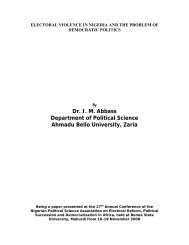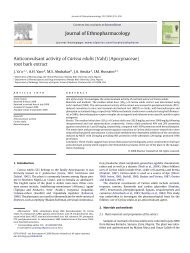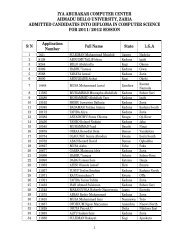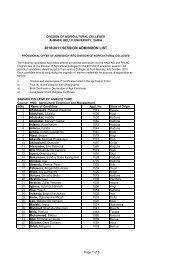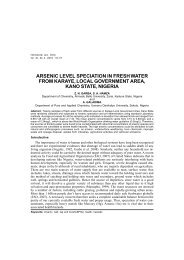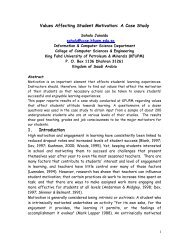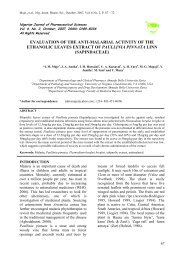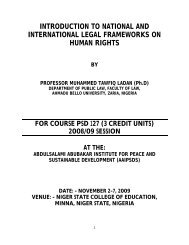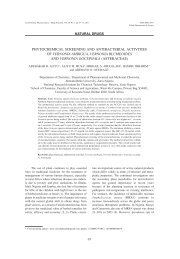preliminary phytochemical and antibacterial screening of the ...
preliminary phytochemical and antibacterial screening of the ...
preliminary phytochemical and antibacterial screening of the ...
Create successful ePaper yourself
Turn your PDF publications into a flip-book with our unique Google optimized e-Paper software.
Katsayal <strong>and</strong> Lamai Nig. Journ. Pharm. Sci., October, 2009, Vol. 8 No. 2, P. 121 – 125<br />
Nigerian Journal <strong>of</strong> Pharmaceutical Sciences<br />
Vol. 8, No. 2, October, 2009, ISSN: 0189-823X<br />
All Rights Reserved<br />
PRELIMINARY PHYTOCHEMICAL AND ANTIBACTERIAL<br />
SCREENING OF THE ETHANOLIC STEM BARK EXTRACT OF<br />
PHYLLANTHUS MUELLERIANUS<br />
*U. A. Katsayal <strong>and</strong> R. S. Lamai<br />
Department <strong>of</strong> Pharmacognosy <strong>and</strong> Drug development, Ahmadu Bello University, Zaria, Nigeria<br />
*Author for Correspondence: uakatsayal@abu.edu.ng, 0803 674 5451<br />
ABSTRACT<br />
Throughout <strong>the</strong> history <strong>of</strong> drug development, natural products have provided a fundamental source <strong>of</strong> drugs for<br />
fighting infections. In this paper <strong>the</strong>refore, <strong>the</strong> <strong>phytochemical</strong> constituents present in <strong>the</strong> stem bark extract <strong>of</strong><br />
Phyllanthus muellerianus were screened <strong>and</strong> its <strong>antibacterial</strong> properties in vitro were determined using agar cup<br />
plate method on selected organisms, namely Bacillus subtilis, Escherichia coli, Pseudomonas aeruginosa <strong>and</strong><br />
Staphylococcus aureus. The <strong>phytochemical</strong> <strong>screening</strong> <strong>of</strong> <strong>the</strong> ethanolic extract <strong>of</strong> <strong>the</strong> stem bark revealed <strong>the</strong><br />
presence <strong>of</strong> carbohydrates, saponins, flavonoids, tannins, alkaloids, steroids <strong>and</strong> triterpenes, cardiac glycosides<br />
<strong>and</strong> anthraquinones. The extract revealed a good concentration dependent <strong>antibacterial</strong> activity against <strong>the</strong> test<br />
organisms similar to that <strong>of</strong> <strong>the</strong> st<strong>and</strong>ard drug, gentamicin with <strong>the</strong> exception <strong>of</strong> Ps. aeruginosa. The observed<br />
effects could not be unrelated to <strong>the</strong> presence <strong>of</strong> <strong>the</strong> chemical constituents in <strong>the</strong> extract. The outcome <strong>of</strong> this<br />
study could <strong>the</strong>refore justify <strong>the</strong> ethnomedicinal uses <strong>of</strong> P. muellerianus.<br />
Keywords:<br />
Phyllanthus muellerianus, Euphobiaceae, <strong>phytochemical</strong> <strong>screening</strong>, <strong>antibacterial</strong> <strong>screening</strong><br />
INTRODUCTION<br />
The Phyllanthus genus contains over 600<br />
species <strong>of</strong> shrubs, trees <strong>and</strong> annual or<br />
biennial herbs distributed throughout <strong>the</strong><br />
tropical <strong>and</strong> subtropical regions <strong>of</strong> both<br />
hemispheres (Taylor, 2003). The plant,<br />
Phyllanthus muellerianus (Kuntze) Exell,<br />
is a glabrous shrub or woody climber,<br />
occasionally arborescent, found in<br />
savannah <strong>and</strong> drier secondary forests<br />
common in coastal thickets <strong>and</strong> scrub <strong>and</strong><br />
widespread in parts <strong>of</strong> tropical Africa<br />
(Hutchinson, 1954) (Plate 1). It has been<br />
used traditionally in <strong>the</strong> treatment <strong>of</strong><br />
various ailments. In Tanganyika, a root<br />
decoction is taken by draught for hard<br />
abscesses, <strong>and</strong> <strong>the</strong> powdered dried root <strong>and</strong><br />
bark is sprinkled on wounds as a dressing<br />
(Burkill, 1985). After removal <strong>of</strong> surface<br />
spines, twigs are used as chewing sticks in<br />
Nigeria <strong>and</strong> in Ivory Coast to prevent<br />
toothache (Burkill, 1985). In Congo, <strong>the</strong><br />
dried bark powder is taken for colds <strong>and</strong><br />
sinusitis (Burkill, 1985). Toge<strong>the</strong>r with<br />
powdered roots, a bark decoction in<br />
draught <strong>and</strong> enema is used for throat<br />
troubles <strong>and</strong> gl<strong>and</strong>ular fevers (Burkill,<br />
1985). O<strong>the</strong>r species include Phyllanthus<br />
amarus, Phyllanthus sellowianus (now<br />
varieties <strong>of</strong> Phyllanthus niruri),<br />
Phyllanthus niruri <strong>and</strong> Phyllanthus<br />
121
Katsayal <strong>and</strong> Lamai Nig. Journ. Pharm. Sci., October, 2009, Vol. 8 No. 2, P. 121 – 125<br />
simplex <strong>of</strong> which Phyllanthus niruri has<br />
been studied extensively <strong>and</strong> shown to<br />
possess <strong>antibacterial</strong> property (Taylor,<br />
2003). The past few decades have<br />
experienced an overwhelming increase in<br />
global interest on <strong>the</strong> practice <strong>of</strong> traditional<br />
medicine <strong>and</strong> its use <strong>of</strong> medicinal plants to<br />
treat illness (Akarele, 1994). Plant-derived<br />
preparations <strong>and</strong> isolated <strong>phytochemical</strong>s<br />
or <strong>the</strong>ir model derivatives may be<br />
potentially useful to treat infectious<br />
diseases, especially in <strong>the</strong> light <strong>of</strong> <strong>the</strong><br />
emergence <strong>of</strong> drug-resistant<br />
microorganisms <strong>and</strong> <strong>the</strong> need to produce<br />
more efficacious <strong>and</strong> cost-effective<br />
antimicrobial agents (Ncube et al., 2008).<br />
The use <strong>of</strong> antibiotics has revolutionized<br />
<strong>the</strong> treatment <strong>of</strong> various bacterial<br />
infections. However, <strong>the</strong>ir indiscriminate<br />
use has led to an alarming increase in<br />
antibiotic resistance among<br />
microorganisms (Hart <strong>and</strong> Karriuri, 1998).<br />
This necessitates <strong>the</strong> need for development<br />
<strong>of</strong> novel antimicrobials (Chopra et al.,<br />
1997). One way <strong>of</strong> preventing antibiotic<br />
resistance <strong>of</strong> pathogenic species is<br />
development <strong>of</strong> new compounds that are<br />
not based on existing syn<strong>the</strong>tic<br />
antimicrobial agents (Rojas et al., 2006).<br />
The present study was <strong>the</strong>refore carried out<br />
to evaluate <strong>the</strong> <strong>preliminary</strong> <strong>phytochemical</strong><br />
<strong>and</strong> <strong>antibacterial</strong> properties <strong>of</strong> <strong>the</strong><br />
ethanolic extract <strong>of</strong> P. muellerianus stem<br />
bark, with <strong>the</strong> aimed <strong>of</strong> providing a lead<br />
compound(s) for <strong>the</strong> development <strong>of</strong> new,<br />
novel <strong>antibacterial</strong> agent(s).<br />
Plate 1: Phyllanthus muellerianus in its Natural Habitat<br />
MATERIALS AND METHODS<br />
Collection <strong>of</strong> Plant Material<br />
The plant, Phyllanthus muellerianus was<br />
collected from behind Ramat Hal, Ahmadu<br />
Bello University main campus in <strong>the</strong><br />
month <strong>of</strong> February, 2009 <strong>and</strong> au<strong>the</strong>nticated<br />
at <strong>the</strong> Herbarium Unit <strong>of</strong> <strong>the</strong> Department<br />
<strong>of</strong> Biological Sciences, Ahmadu Bello<br />
University, Zaria where it was assigned a<br />
voucher specimen number (925) by<br />
Mallam Umar Gallah.<br />
Solvent <strong>and</strong> Drugs <strong>and</strong> Test Organisms<br />
The solvent used for <strong>the</strong> extraction <strong>of</strong> <strong>the</strong><br />
plant material is <strong>of</strong> Analar grade, <strong>and</strong> was<br />
purchased from Sigma-Aldrich<br />
representative in Nigeria. The st<strong>and</strong>ard<br />
drug used in this experiment, gentamicin,<br />
122
Katsayal <strong>and</strong> Lamai Nig. Journ. Pharm. Sci., October, 2009, Vol. 8 No. 2, P. 121 – 125<br />
was obtained from Lek Pharmaceutical<br />
Company Limited, Slovenia. The test<br />
organisms were obtained from <strong>the</strong><br />
Department <strong>of</strong> Pharmaceutics <strong>and</strong><br />
Pharmaceutical Microbiology, Ahmadu<br />
Bello University, Zaria.<br />
Processing <strong>of</strong> <strong>the</strong> Plant Material<br />
The stem bark was removed manually; air<br />
dried under shade <strong>and</strong> powdered using a<br />
wooden pestle <strong>and</strong> mortar. The preferable<br />
solvent used by <strong>the</strong> local people is mostly<br />
water <strong>and</strong>/or local gin; <strong>the</strong>refore, <strong>the</strong><br />
extraction <strong>of</strong> <strong>the</strong> plant material was<br />
performed by weighing 100 g <strong>of</strong> <strong>the</strong> air<br />
dried, milled root-bark <strong>of</strong> Phyllanthus<br />
muellerianus <strong>and</strong> exhaustively extracted<br />
by repeated maceration with 70 % v/v<br />
aqueous-ethanol at room temperature. The<br />
alcoholic solutions were combined <strong>and</strong><br />
evaporated to dryness at 45 °C under<br />
reduced pressure to obtain a dry extract<br />
which was weighed to yield 8.7 % <strong>and</strong><br />
stored in a desiccator before used.<br />
Phytochemical Screening<br />
Phytochemical <strong>screening</strong> <strong>of</strong> <strong>the</strong> ethanolic<br />
extract was carried using st<strong>and</strong>ard methods<br />
(Evans, 2002; S<strong>of</strong>owora, 2008) to screen<br />
for <strong>the</strong> presence <strong>of</strong> various chemical<br />
constituents.<br />
Test Organisms<br />
St<strong>and</strong>ard type cultures <strong>of</strong> Bacillus subtilis<br />
(NCTC 10342), Escherichia coli (ATCC<br />
11775), Pseudomonas aeruginosa (ATCC<br />
10145) <strong>and</strong> Staphylococcus aureus (ATCC<br />
021001) were kindly obtained from <strong>the</strong><br />
Department <strong>of</strong> Pharmaceutics <strong>and</strong><br />
Pharmaceutical Microbiology, Ahmadu<br />
Bello University, Zaria were used in this<br />
study.<br />
St<strong>and</strong>ardization <strong>of</strong> Inoculum<br />
The bacterial cultures were prepared by<br />
transferring 2 to 3 colonies into bacteria<br />
growth medium (Luria broth agar) <strong>and</strong><br />
incubated at 37° C for 14 hrs before use as<br />
described by El<strong>of</strong>f (1998). The cells were<br />
maintained in Luria agar (10 g/l Bacto<br />
tryptone, 5 g/l Bacto yeast extract, 10 g/l<br />
NaCl at pH 7.0) in glass slant bottles.<br />
Antimicrobial Activity Determination<br />
Antibacterial <strong>screening</strong> was performed<br />
using an Agar diffusion method as<br />
described by Hugo <strong>and</strong> Russell, 1998. The<br />
plates were prepared in duplicate using<br />
nutrient agar. Three concentrations (10<br />
mg/ml, 50 mg/ml <strong>and</strong> 100 mg/ml) <strong>of</strong> <strong>the</strong><br />
extract in sterile water were prepared.<br />
St<strong>and</strong>ard gentamicin, 2.5 mg/ml was<br />
employed as positive control. The plates<br />
were inoculated with st<strong>and</strong>ardized cultures<br />
<strong>of</strong> B. subtilis, S. aureus, E. coli <strong>and</strong> Ps.<br />
aeruginosa by flooding. Using <strong>the</strong> cup<br />
plate method described by Hugo <strong>and</strong><br />
Russell (1998), a sterile cork borer was<br />
used to make 4 holes <strong>of</strong> about 8 mm in<br />
diameter into <strong>the</strong> solidified agar in each<br />
plate. 0.1ml <strong>of</strong> each concentration <strong>of</strong> <strong>the</strong><br />
extract <strong>and</strong> <strong>the</strong> reference drug were applied<br />
in separate holes in each prepared plate.<br />
The plates were covered <strong>and</strong> kept for an<br />
hour to allow <strong>the</strong> extract <strong>and</strong> <strong>the</strong> st<strong>and</strong>ard<br />
drug to diffuse, before transferring to an<br />
incubator at 37° C for 18 hours after which<br />
zones <strong>of</strong> inhibition were measured to <strong>the</strong><br />
nearest millimetre.<br />
RESULTS AND DISCUSSION<br />
The <strong>preliminary</strong> <strong>phytochemical</strong> <strong>screening</strong><br />
revealed <strong>the</strong> presence <strong>of</strong> alkaloids, tannins,<br />
flavonoids, anthraquinones, saponins,<br />
steroids <strong>and</strong> reducing sugars (Table 1).<br />
Plants used in <strong>the</strong> treatment <strong>of</strong> disease are<br />
said to contain active principles which are<br />
<strong>phytochemical</strong>s with biological activity,<br />
some <strong>of</strong> which are responsible for <strong>the</strong><br />
characteristic odours, pungencies <strong>and</strong><br />
colours <strong>of</strong> plants while o<strong>the</strong>rs give a<br />
particular plant its culinary, medicinal or<br />
poisonous virtues (Evans, 2002). From <strong>the</strong><br />
result <strong>of</strong> <strong>the</strong> <strong>phytochemical</strong> <strong>screening</strong>, <strong>the</strong><br />
extract was found to contain saponins,<br />
flavonoids <strong>and</strong> tannins which are well-<br />
123
Katsayal <strong>and</strong> Lamai Nig. Journ. Pharm. Sci., October, 2009, Vol. 8 No. 2, P. 121 – 125<br />
known to possess antimicrobial activities<br />
(Akiyama et al, 2001). Flavonoids have<br />
been reported to be syn<strong>the</strong>sized by plants<br />
in response to microbial infection <strong>and</strong> have<br />
been shown to have <strong>antibacterial</strong> activities<br />
(Kujumgiev et al., 1999). Tannins were<br />
also reported have demonstrated activity<br />
against bacteria (Akiyama et al, 2001).<br />
These kinds <strong>of</strong> compounds were found to<br />
be present in <strong>the</strong> extract <strong>of</strong> this plant<br />
(Table 1). The extract was found to<br />
demonstrate a good <strong>antibacterial</strong> activity<br />
against Bacillus subtilis, Staphylococcus<br />
aureus <strong>and</strong> Escherichia coli with<br />
exception <strong>of</strong> Pseudomonas aeruginosa<br />
(Table 2). This was measured using zone<br />
<strong>of</strong> inhibition with a measurement <strong>of</strong><br />
greater than or equal to 10 mm indicating<br />
good <strong>antibacterial</strong> activity (Kujumgiev et<br />
al., 1999). A concentration dependent<br />
activity was exhibited by <strong>the</strong> extract<br />
against <strong>the</strong>se organisms, an increase in<br />
concentration giving rise to an increase in<br />
<strong>the</strong> zone <strong>of</strong> inhibition. Evaluation <strong>of</strong> <strong>the</strong><br />
leaf extract was also found to show good<br />
<strong>antibacterial</strong> activity at high<br />
concentrations, with lowest activity against<br />
S. aureus. Both leaf <strong>and</strong> bark extracts have<br />
been shown to have high <strong>antibacterial</strong><br />
activity (Doughhari <strong>and</strong> Sunday, 2008).<br />
Chlor<strong>of</strong>orm leaf extract <strong>of</strong> this plant was<br />
also shown to have good activity against<br />
C. albicans, S. aureus <strong>and</strong> E. coli (Onocha<br />
et al, 2003). O<strong>the</strong>r species <strong>of</strong> this genus<br />
were also found to demonstrate<br />
<strong>antibacterial</strong> <strong>and</strong> even antiviral activity<br />
(Taylor, 2003). The findings <strong>of</strong> this study,<br />
could <strong>the</strong>refore justify <strong>the</strong> use <strong>of</strong> this plant<br />
in traditional medicine in <strong>the</strong> treatment <strong>of</strong><br />
bacterial infections.<br />
Table 1:<br />
Preliminary Phytochemical <strong>screening</strong> <strong>of</strong> <strong>the</strong> ethanolic stem barks extract<br />
<strong>of</strong> P. muellerianus<br />
Constituents<br />
Inference<br />
Alkaloids +<br />
Anthraquinones +<br />
Cardiac glycosides +<br />
Flavonoids +<br />
Reducing sugars +<br />
Saponins +<br />
Tannins +<br />
Unsaturated steroids<br />
And triterpenes +<br />
Key: + = Present<br />
Table 2:<br />
Antibacterial activity <strong>of</strong> <strong>the</strong> ethanolic stem bark extract <strong>of</strong> P. muellerianus<br />
Diameter <strong>of</strong> zone <strong>of</strong> inhibition (mm)<br />
Extract/Drug B. subtilis S. aureus E. coli Ps. aeruginosa<br />
(Mg/ml)<br />
10 16.5 14.0 0.0 0.0<br />
50 19.0 17.5 14.5 0.0<br />
100 19.0 20.0 16.0 0.0<br />
Gentamicin<br />
(2.5)<br />
40.0 42.0 40.0 42.5<br />
Cork Borer Diameter: 8 mm<br />
124
Katsayal <strong>and</strong> Lamai Nig. Journ. Pharm. Sci., October, 2009, Vol. 8 No. 2, P. 121 – 125<br />
ACKNOWLEDGEMENT<br />
We thank <strong>the</strong> staff <strong>of</strong> <strong>the</strong> Herbarium Unit<br />
<strong>of</strong> <strong>the</strong> Department <strong>of</strong> Biological Sciences,<br />
Ahmadu Bello University, Zaria for<br />
au<strong>the</strong>nticating <strong>the</strong> identity <strong>of</strong> <strong>the</strong> plant <strong>and</strong><br />
Mr. Ezekiel <strong>of</strong> <strong>the</strong> Department <strong>of</strong><br />
Pharmaceutics <strong>and</strong> Pharmaceutical<br />
Microbiology, Ahmadu Bello University,<br />
Zaria for his technical assistance in<br />
carrying out <strong>the</strong> antimicrobial <strong>screening</strong>.<br />
REFERENCES<br />
Akerele, O. (1994). Nature's Medicinal Bounty: Do<br />
not throw it away. World Health Forum 14: 390-<br />
395.<br />
Akiyama, H.; Fujii, K.; Yamasaki, O.; Oono, T.<br />
<strong>and</strong> Iwatsuki, K. (2001). Antibacterial Action <strong>of</strong><br />
Several Tannins Against Staphylococcus aureus,<br />
Journal <strong>of</strong> Antimicrobial Chemo<strong>the</strong>rapy, 48 (4):<br />
487- 491.<br />
Burkill, H. M. (1985). The Useful Plants <strong>of</strong> West<br />
Tropical Africa, Vol. 2, Royal Botanic Gardens,<br />
Kew.<br />
Chopra, I., Hodgson, J., Metcalf, B., Poste, G.<br />
(1997). The Search for Anti-bacterial Agents<br />
Effective Against Bacterial Resistance to Multiple<br />
Antibiotics. Antimicrob. Agents Chemo<strong>the</strong>r. 41:<br />
497-503.<br />
Doughari, J. H. <strong>and</strong> Sunday, D. (2008).<br />
Antibacterial Activity <strong>of</strong> Phyllanthus muellerianus,<br />
Pharmaceutical Biology, 46 (6): 400-405.<br />
Evans, W. C. (2002). Trease <strong>and</strong> Evans<br />
Pharmacognosy, (15 th edition), W.B. Saunders<br />
Company Ltd., London, Pp. 191-393.<br />
Hart, C. A., Karriuri, S. (1998). Antimicrobial<br />
Resistance in Developing Countries. Br. Med. J.,<br />
317: 421-452.<br />
Hugo, W. B. <strong>and</strong> Russell, A. D. (1998).<br />
Pharmaceutical Microbiology, 6 th edition,<br />
Blackwell Sciences Ltd, Oxford, P. 24.<br />
El<strong>of</strong>f, J. N. (1998). A Sensitive <strong>and</strong> Quick Method<br />
to Determine <strong>the</strong> Minimum Inhibitory<br />
Concentration <strong>of</strong> Plant Extracts for Bacteria. Planta<br />
Medica, 60: 1-8.<br />
Hutchinson, J., <strong>and</strong> Dalziel, J.M. (1954). Flora <strong>of</strong><br />
West Tropical Africa, 2 nd edition, Vol. 1 Part 1,<br />
Crown agents for Oversea Governments <strong>and</strong><br />
administrations, Mill bank, London, p 384.<br />
Kujumgiev A., Tsvetkoval, Serkedjievay, Bankova<br />
V., Christo, R. <strong>and</strong> Popov, S. (1999). Antibacterial,<br />
antifungal <strong>and</strong> antiviral activity <strong>of</strong> propolis<br />
geographic origin, Journal <strong>of</strong> Ethnopharmacology<br />
44: 35- 40.<br />
Ncube, N. S., Afolayan, A. J., Okoh, A. I. (2008).<br />
Assessment Techniques <strong>of</strong> Antimicrobial<br />
Properties <strong>of</strong> Natural Compounds <strong>of</strong> Plant Origin:<br />
Current methods <strong>and</strong> future trends. Afr. J. Biotech.<br />
7: 1997-1806.<br />
Onocha, P. A., Opegbemi, A. O., Kadri A. O.,<br />
Ajayi, K. M. <strong>and</strong> Okorie, D. A. (2003).<br />
Antimicrobial Evaluation <strong>of</strong> Nigerian<br />
Euphobiaceae Plants 1: Phyllanthus amarus <strong>and</strong><br />
Phyllanthus muellerianus leaf extracts, Nigerian<br />
Journal <strong>of</strong> Natural Products <strong>and</strong> Medicine 7: 9-12.<br />
Rojas, J. J., Ochoa, V. J., Ocampo, S. A., Munoz, J.<br />
F. (2006). Screening for Antimicrobial Activity <strong>of</strong><br />
Ten Medicinal Plants Used in Colombian Folkloric<br />
Medicine: A possible alternative in treatment <strong>of</strong><br />
nonnosocomial infections. BMC Complement.<br />
Altern. Med., 6: 2 doi: 10.1186/1472-6882-6-2.<br />
S<strong>of</strong>owora, A. (2008). Medicinal Plants <strong>and</strong><br />
Traditional Medicine in Africa, (3 rd edition),<br />
Spectrum Books Ltd. Ibadan, Nigeria, Pp. 199-<br />
205.<br />
Taylor, L. (2003). Herbal Secrets <strong>of</strong> <strong>the</strong> Rainforest,<br />
(2 nd edition), Sage Press, Inc. Texas, USA, P. 1.<br />
125



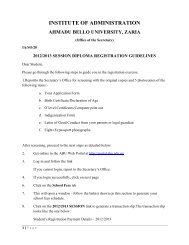
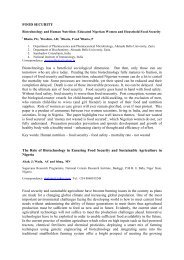

![Full Paper [PDF]](https://img.yumpu.com/49740055/1/184x260/full-paper-pdf.jpg?quality=85)
